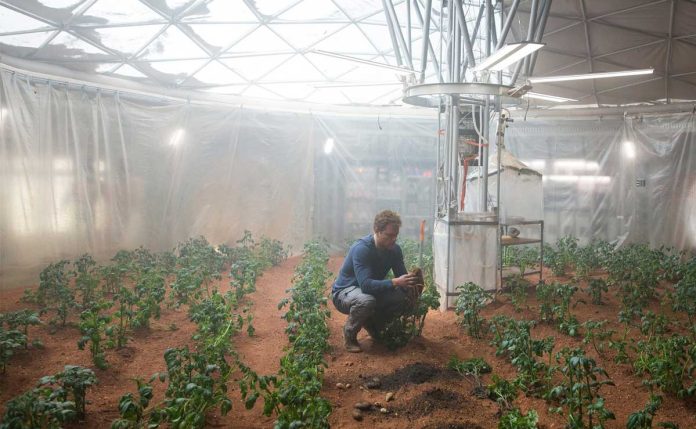In the hit movie, “The Martian,” stranded astronaut Mark Watney famously survives on Mars by creating a potato garden using Martian soil mixed in with composted human excrement. According to a Sunday story in CNET, NASA believes that the movie is on the right track as far as astronauts growing their own food on long-duration space missions. However, some caveats exists concerning how the film depicted space agriculture.
NASA has been researching space gardens for decades. The idea is that growing food will help supplement supplies that astronauts will take on long-duration space missions. Space agriculture would also help with air recycling, turning CO2 back into oxygen. Having green, growing things would also have a beneficial psychological effects on future astronauts.
NASA’s approach, though, would involve hydroponics, using water permeated with nutrients and bright lights to grow food. Recently astronauts on the International Space Station grew salad greens and made a meal out of them.
However, according to Bruce Bugbee, director of the Plants, Soils & Climate Department at Utah State University, two problems existed with the way Mark Watney approached the problem of growing a garden on Mars.
One problem concerns light, according to Bugbee.
“The biggest problem, he said, is that Mars is about 1.5 times farther from the sun than the Earth is, and only gets about 60 percent of the light. This means that plants on Mars would grow at about 60 percent of the rate of Earth plants, even when exposed to full Mars light. Watney’s habitat was designed to block radiation, which would lower the light levels even more.”
Then, the nature of the Martian soil presents another problem.
“It’s mostly iron oxides. And iron makes stuff red, like rust. So it would be pretty hard to just take soil the way he did in the movie and put a little bit of composted human waste on the plants, and magically grow these great potatoes.”
The first Mars explorers will use hydroponics to grow their own food. Thus, humans will bring the first life to the Red Planet in several billion years.















